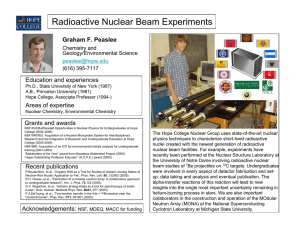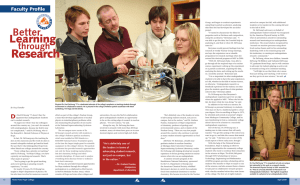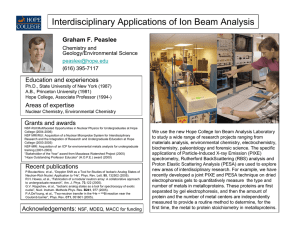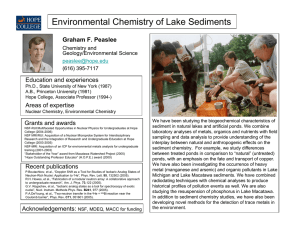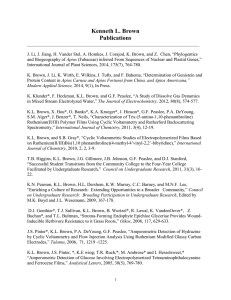Learning
advertisement
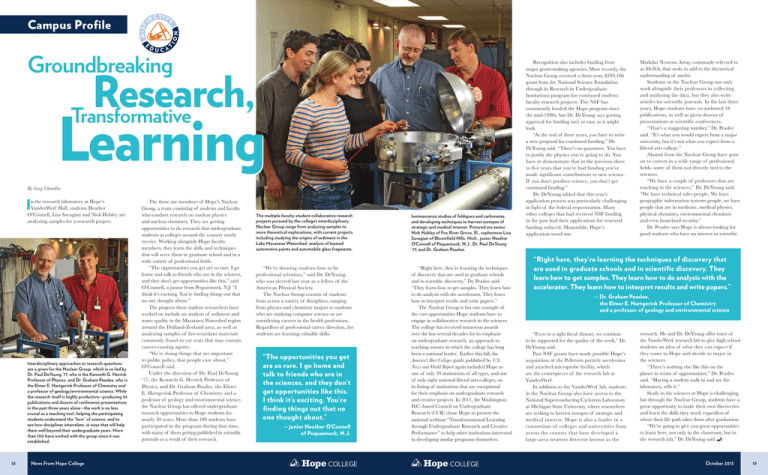
Campus Profile Groundbreaking Research, Transformative Learning By Greg Chandler I n the research laboratory at Hope’s VanderWerf Hall, students Heather O’Connell, Lisa Savagian and Nick Hubley are analyzing samples for a research project. Interdisciplinary approaches to research questions are a given for the Nuclear Group, which is co-led by Dr. Paul DeYoung ’77, who is the Kenneth G. Herrick Professor of Physics, and Dr. Graham Peaslee, who is the Elmer E. Hartgerink Professor of Chemistry and a professor of geology/environmental science. While the research itself is highly productive—producing 34 publications and dozens of conference presentations in the past three years alone—the work is no less crucial as a teaching tool, helping the participating students understand the “how” of science, and to see how disciplines interrelate, in ways that will help them well beyond their undergraduate years. More than 100 have worked with the group since it was established. 18 News News From From Hope Hope College College The three are members of Hope’s Nuclear Group, a team consisting of students and faculty who conduct research on nuclear physics and nuclear chemistry. They are getting opportunities to do research that undergraduate students at colleges around the country rarely receive. Working alongside Hope faculty members, they learn the skills and techniques that will serve them in graduate school and in a wide variety of professional fields. “The opportunities you get are so rare. I go home and talk to friends who are in the sciences, and they don’t get opportunities like this,” said O’Connell, a junior from Pequannock, N.J. “I think it’s exciting. You’re finding things out that no one thought about.” The projects these student researchers have worked on include an analysis of sediment and water quality in the Macatawa Watershed region around the Holland-Zeeland area, as well as analyzing samples of fire-retardant materials commonly found in car seats that may contain cancer-causing agents. “We’re doing things that are important to public policy, that people care about,” O’Connell said. Under the direction of Dr. Paul DeYoung ‘77, the Kenneth G. Herrick Professor of Physics, and Dr. Graham Peaslee, the Elmer E. Hartgerink Professor of Chemistry and a professor of geology and environmental science, the Nuclear Group has offered undergraduate research opportunities to Hope students for nearly 30 years. More than 100 students have participated in the program during that time, with many of them getting published in scientific journals as a result of their research. The multiple faculty-student collaborative research projects pursued by the college’s interdisciplinary Nuclear Group range from analyzing samples to more theoretical explorations, with current projects including studying the origins of sediment in the Lake Macatawa Watershed, analysis of layered automotive paints and automobile glass fragments, luminescence studies of feldspars and carbonates, and developing techniques to harvest isotopes of strategic and medical interest. Pictured are senior Nick Hubley of Fox River Grove, Ill., sophomore Lisa Savagian of Bloomfield Hills, Mich., junior Heather O’Connell of Pequannock, N.J., Dr. Paul DeYoung ’77, and Dr. Graham Peaslee. “We’re showing students how to be professional scientists,” said Dr. DeYoung, who was elected last year as a fellow of the American Physical Society. The Nuclear Group consists of students from across a variety of disciplines, ranging from physics and chemistry majors to students who are studying computer science or are considering careers in the health professions. Regardless of professional career direction, the students are learning valuable skills. “Right here, they’re learning the techniques of discovery that are used in graduate schools and in scientific discovery,” Dr. Peaslee said. “They learn how to get samples. They learn how to do analysis with the accelerator. They learn how to interpret results and write papers.” The Nuclear Group is but one example of the vast opportunities Hope students have to engage in collaborative research in the sciences. The college has received numerous awards over the last several decades for its emphasis on undergraduate research, an approach to teaching science in which the college has long been a national leader. Earlier this fall, the America’s Best Colleges guide published by U.S. News and World Report again included Hope as one of only 39 institutions of all types, and one of only eight national liberal arts colleges, on its listing of institutions that are exceptional for their emphasis on undergraduate research and creative projects. In 2011, the Washington, D.C.-based Council on Undergraduate Research (CUR) chose Hope to present the national webinar “Transformational Learning through Undergraduate Research and Creative Performance” to help other institutions interested in developing similar programs themselves. “The opportunities you get are so rare. I go home and talk to friends who are in the sciences, and they don’t get opportunities like this. I think it’s exciting. You’re finding things out that no one thought about.” — junior Heather O’Connell of Pequannock, N.J. Recognition also includes funding from major grant-making agencies. Most recently, the Nuclear Group received a three-year, $299,106 grant from the National Science Foundation through its Research in Undergraduate Institutions program for continued studentfaculty research projects. The NSF has consistently funded the Hope program since the mid-1990s, but Dr. DeYoung says getting approval for funding isn’t as easy as it might look. “At the end of three years, you have to write a new proposal for continued funding,” Dr. DeYoung said. “There’s no guarantee. You have to justify the physics you’re going to do. You have to demonstrate that in the previous three to five years that you’ve had funding you’ve made significant contributions to new science. If you don’t produce science, you don’t get continued funding.” Dr. DeYoung added that this year’s application process was particularly challenging in light of the federal sequestration. Many other colleges that had received NSF funding in the past had their applications for renewed funding reduced. Meanwhile, Hope’s application stood out. Modular Neutron Array, commonly referred to as MoNA, that seeks to add to the theoretical understanding of nuclei. Students in the Nuclear Group not only work alongside their professors in collecting and analyzing the data, but they also write articles for scientific journals. In the last three years, Hope students have co-authored 34 publications, as well as given dozens of presentations at scientific conferences. “That’s a staggering number,” Dr. Peaslee said. “It’s what you would expect from a major university, but it’s not what you expect from a liberal arts college.” Alumni from the Nuclear Group have gone on to careers in a wide range of professional fields, some of them not directly tied to the sciences. “We have a couple of professors that are teaching in the sciences,” Dr. DeYoung said. “We have technical sales people. We have geographic information systems people, we have people that are in medicine, medical physics, physical chemistry, environmental chemistry and even homeland security.” Dr. Peaslee says Hope is always looking for good students who have an interest in scientific “Right here, they’re learning the techniques of discovery that are used in graduate schools and in scientific discovery. They learn how to get samples. They learn how to do analysis with the accelerator. They learn how to interpret results and write papers.” — Dr. Graham Peaslee, the Elmer E. Hartgerink Professor of Chemistry and a professor of geology and environmental science “Even in a tight fiscal climate, we continue to be supported for the quality of the work,” Dr. DeYoung said. Past NSF grants have made possible Hope’s acquisition of the Pelletron particle accelerator and attached microprobe facility, which are the centerpieces of the research lab at VanderWerf. In addition to the VanderWerf lab, students in the Nuclear Group also have access to the National Superconducting Cyclotron Laboratory at Michigan State University, where researchers are seeking to harvest isotopes of strategic and medical interest. Hope is also a leader in a consortium of colleges and universities from across the country that have developed a large-area neutron detector known as the research. He and Dr. DeYoung offer tours of the VanderWerf research lab to give high school students an idea of what they can expect if they come to Hope and decide to major in the sciences. “There’s nothing else like this on the planet in terms of opportunities,” Dr. Peaslee said. “Having a student walk in and see the laboratory, sells it.” Study in the sciences at Hope is challenging, but through the Nuclear Group, students have a great opportunity to make their own discoveries and learn the skills they need, regardless of where their life path takes them after graduation. “We’re going to give you great opportunities to learn here, not only in the classroom, but in the research lab,” Dr. DeYoung said. June 2012 October 2013 19
